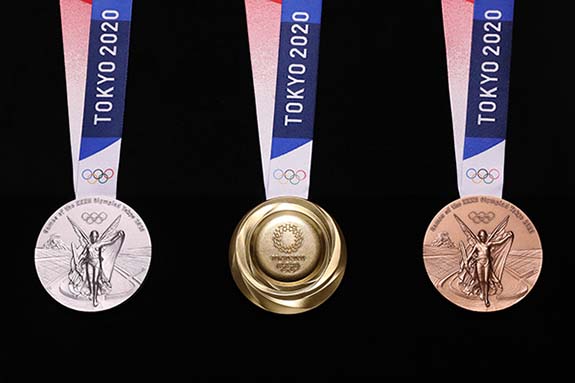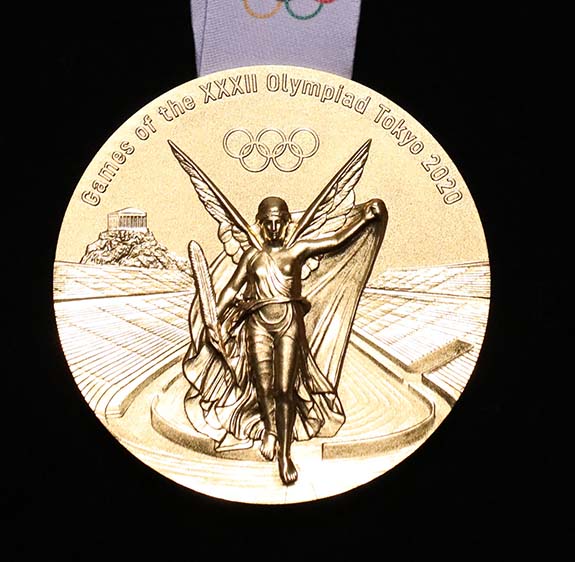July 30th, 2019
Gold, silver and bronze medals created entirely from recycled mobile phones and other electronic devices were unveiled by the 2020 Tokyo Olympic Games organizers. This is the first Olympic committee to create medals from 100% recycled material. By contrast, less than one-third of the material used to create the medals of the 2016 Rio Games were recycled.

The gold and silver medals will be the heaviest ever used at the Summer Games, weighing in at 556 and 550 grams, with a diameter of 85 millimeters – 7.7mm at their thinnest part and 12.1mm at their thickest.

The front depicts Nike, the mythical Greek goddess of victory, standing in front of the Panathinaikos Stadium. The back features a raised, pebble-like center, reflective Olympic rings, and a checkered Tokyo 2020 "ichimatsu moyo" emblem inside a swirl design. The side of each medal will be inscribed with the name of the event for which it is presented.

Junichi Kawanishi designed the medals to resemble rough stones that have been newly polished, and now "shine with light and brilliance." Set at varied angles, each layer reflects light differently to symbolize the energy and commitment of the athletes and their supporters.
Kawanishi also wanted the medals to symbolize diversity and convey the concept that to achieve glory, athletes have to strive for victory on a daily basis.
"With their shining rings, I hope the medals will be seen as paying tribute to the athletes' efforts, reflecting their glory and symbolizing their friendship," said Kawanishi.
The Olympic gold medals are made mostly of silver, containing just six grams of pure gold. The silver medals are pure silver. The bronze medals are made from gunmetal, a corrosion-resistant form of bronze that contains zinc. Olympic gold medals were once made of solid gold, with the last ones awarded in Stockholm, Sweden, back in 1912.
Approximately 5,000 medals will be manufactured from the precious metals extracted from small used devices donated by the Japanese public in a campaign that ran from April 2017 through March 2019.
The Tokyo 2020 Medal Project encouraged Japanese citizens to donate their used mobile phones, digital cameras, laptops and games units so small amounts of precious metal could be harvested. By the end of March 2019, the collection goal had been achieved – nearly 80,000 tons of devices were collected yielding 32kg of gold, 3,500kg of silver and 2,200kg of bronze.
Despite being a country with virtually no precious metal mining, Japan’s discarded small consumer electronics is believed to contain the equivalent of 16% of the world’s gold reserves and 22% of the world’s silver reserves.
The Olympic medals are hung from ribbons made from recycled polyester and feature traditional Japanese designs with the checked pattern of the Tokyo 2020 logo.

The medal cases, manufactured from dyed Japanese ash wood, were handmade by Japanese craftsmen.
"Like the athletes who will receive the medals, each one is unique," said the organizers.
The 2020 Paralympic medal designs will be revealed in August.
Credits: Images courtesy of Tokyo 2020.

The gold and silver medals will be the heaviest ever used at the Summer Games, weighing in at 556 and 550 grams, with a diameter of 85 millimeters – 7.7mm at their thinnest part and 12.1mm at their thickest.

The front depicts Nike, the mythical Greek goddess of victory, standing in front of the Panathinaikos Stadium. The back features a raised, pebble-like center, reflective Olympic rings, and a checkered Tokyo 2020 "ichimatsu moyo" emblem inside a swirl design. The side of each medal will be inscribed with the name of the event for which it is presented.

Junichi Kawanishi designed the medals to resemble rough stones that have been newly polished, and now "shine with light and brilliance." Set at varied angles, each layer reflects light differently to symbolize the energy and commitment of the athletes and their supporters.
Kawanishi also wanted the medals to symbolize diversity and convey the concept that to achieve glory, athletes have to strive for victory on a daily basis.
"With their shining rings, I hope the medals will be seen as paying tribute to the athletes' efforts, reflecting their glory and symbolizing their friendship," said Kawanishi.
The Olympic gold medals are made mostly of silver, containing just six grams of pure gold. The silver medals are pure silver. The bronze medals are made from gunmetal, a corrosion-resistant form of bronze that contains zinc. Olympic gold medals were once made of solid gold, with the last ones awarded in Stockholm, Sweden, back in 1912.
Approximately 5,000 medals will be manufactured from the precious metals extracted from small used devices donated by the Japanese public in a campaign that ran from April 2017 through March 2019.
The Tokyo 2020 Medal Project encouraged Japanese citizens to donate their used mobile phones, digital cameras, laptops and games units so small amounts of precious metal could be harvested. By the end of March 2019, the collection goal had been achieved – nearly 80,000 tons of devices were collected yielding 32kg of gold, 3,500kg of silver and 2,200kg of bronze.
Despite being a country with virtually no precious metal mining, Japan’s discarded small consumer electronics is believed to contain the equivalent of 16% of the world’s gold reserves and 22% of the world’s silver reserves.
The Olympic medals are hung from ribbons made from recycled polyester and feature traditional Japanese designs with the checked pattern of the Tokyo 2020 logo.

The medal cases, manufactured from dyed Japanese ash wood, were handmade by Japanese craftsmen.
"Like the athletes who will receive the medals, each one is unique," said the organizers.
The 2020 Paralympic medal designs will be revealed in August.
Credits: Images courtesy of Tokyo 2020.


